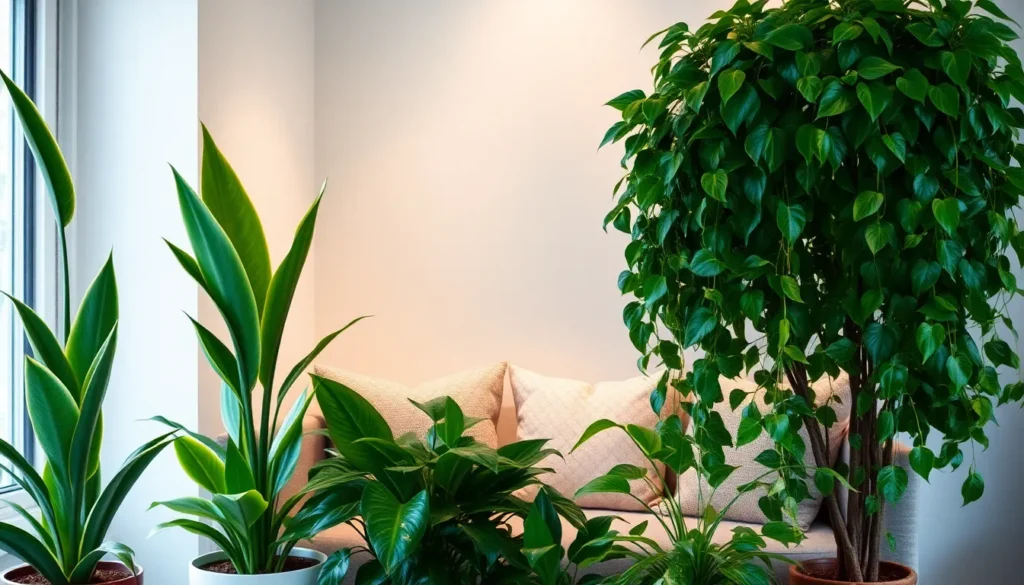We’ve all been there – staring at that dark corner of our home wondering if we can somehow bring life to it with greenery. The good news? You absolutely can transform those shadowy spaces with stunning plants that thrive without direct sunlight.
No-light indoor plants aren’t just surviving in darkness – they’re actually flourishing in low-light conditions that would kill most other houseplants. These resilient beauties have adapted to live comfortably in the filtered light of your living room corner or that windowless bathroom you’ve been trying to spruce up.
Whether you’re dealing with a basement office or simply want to add greenery to every nook and cranny of your home, we’ll show you exactly which plants will turn your darkest spaces into thriving green sanctuaries. Get ready to discover how easy it is to create an indoor jungle – even where the sun doesn’t shine.
Snake Plants: The Ultimate Low-Light Survivors
Snake plants stand out as champions among dark corner plants, earning their reputation through remarkable adaptability to low light conditions. These architectural beauties transform shadowy spaces into striking focal points with minimal effort required.
Sansevieria Varieties That Thrive in Darkness
Sansevieria trifasciata ‘Laurentii’ dominates the low light plant category with its classic yellow bordered leaves that maintain vibrant coloration even in dim environments. We’ve observed this variety thriving in offices with only fluorescent lighting for months without showing stress signs.
Sansevieria cylindrica offers a unique sculptural element with its round, spear-like leaves that grow upright in tight clusters. This variety tolerates near darkness better than most houseplants, making it perfect for basement corners or interior hallways.
Sansevieria ‘Black Gold’ features deep green leaves with golden yellow margins that actually intensify in lower light conditions. We recommend this cultivar for spaces receiving less than 50 foot-candles of light daily.
Sansevieria kirkii ‘Silver Blue’ brings an unusual blue-green hue to dark spaces while maintaining the family’s legendary low light tolerance. This variety reaches only 6 inches tall, making it ideal for small dark corners or tabletop displays.
Care Tips for Snake Plants in Dimly Lit Spaces
Watering frequency decreases significantly in low light environments since snake plants enter a slower metabolic state. We suggest watering every 4-6 weeks during winter months and every 2-3 weeks in summer for plants in dark locations.
Soil drainage becomes even more critical when light levels drop because excess moisture lingers longer in cooler, dimmer conditions. Mix standard potting soil with perlite or sand at a 2:1 ratio to prevent root rot.
Fertilizing should occur sparingly since low light plants process nutrients more slowly than their sun-loving counterparts. Apply diluted liquid fertilizer once during spring and skip feeding entirely during fall and winter months.
Dusting leaves regularly improves the plant’s ability to photosynthesize in already limited light conditions. Wipe leaves with a damp cloth monthly to remove dust buildup that blocks precious light absorption.
Rotating positions occasionally helps maintain even growth patterns since snake plants naturally lean toward available light sources. Turn your plant 90 degrees every few months to encourage straight, upright growth.
ZZ Plants: Glossy Green Beauties for Dark Corners
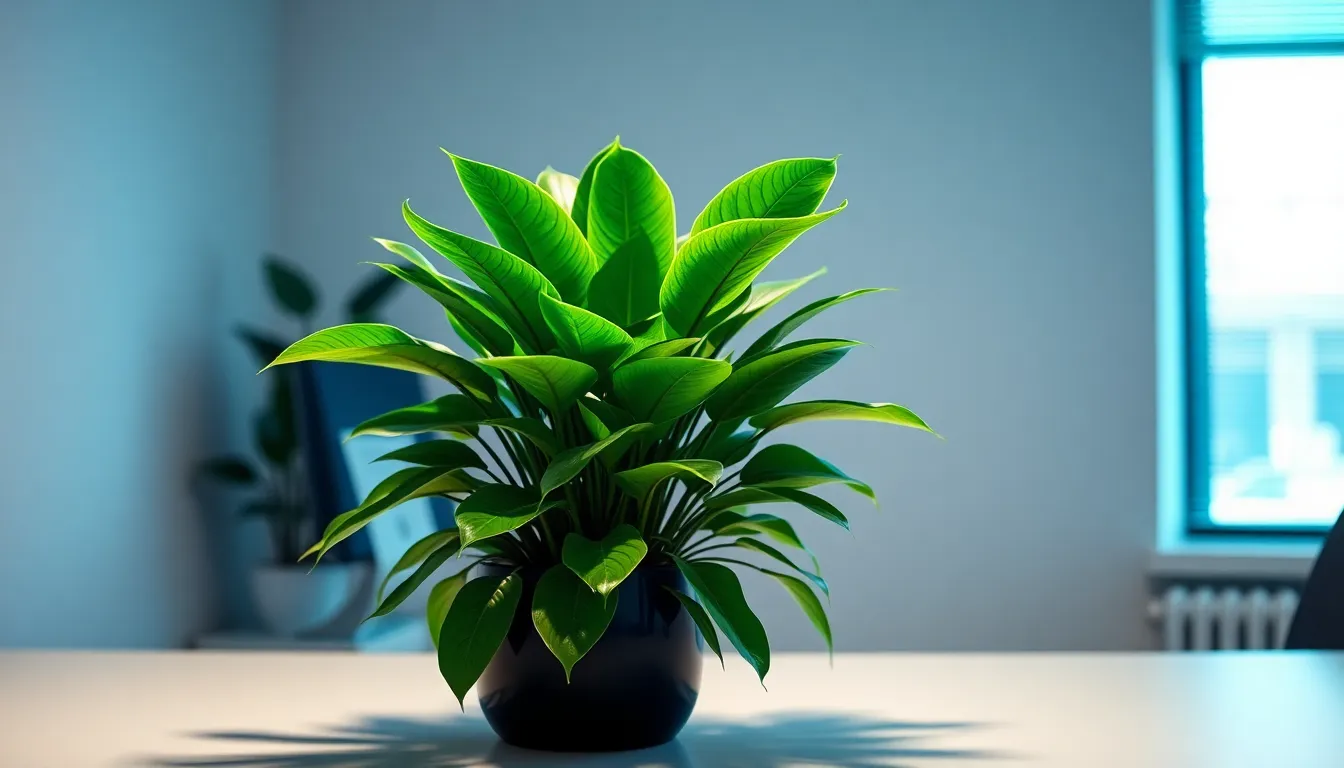
Following our exploration of snake plants, we turn to another exceptional dark corner champion. ZZ plants offer stunning glossy foliage that maintains its vibrant appearance even in challenging lighting conditions.
Why ZZ Plants Excel in No Light Conditions
Physiological adaptations make ZZ plants (Zamioculcas zamiifolia) remarkably tolerant of low light environments where other houseplants struggle to survive. Their ability to maintain lush green foliage stems from specialized mechanisms that allow minimal photosynthesis while preserving their attractive appearance.
Office spaces and windowless rooms become perfect homes for these resilient plants, as they can thrive under fluorescent lighting conditions. Growth rates slow in very dim conditions, but the plants continue to maintain their structural integrity and glossy leaf appearance.
Dark corners throughout your home transform into green focal points when you place ZZ plants strategically in these challenging spots. Unlike many houseplants that become leggy or lose their color in low light, ZZ plants retain their compact form and rich green coloration.
Survival mechanisms allow these plants to store energy efficiently, enabling them to go extended periods without optimal lighting conditions. We’ve found that ZZ plants can maintain their health in environments that would cause other plants to decline rapidly.
Watering and Maintenance for Indoor ZZ Plants
Watering schedules for ZZ plants require patience and restraint, as these drought tolerant specimens prefer soil to dry completely between waterings. We recommend waiting 2 to 3 weeks between watering sessions to prevent root rot, which is the most common cause of ZZ plant failure.
Light supplementation becomes beneficial when your ZZ plant resides in extremely dark conditions for extended periods. Position LED or fluorescent grow lights 12 to 18 inches above your plant, running them for 12 to 16 hours daily to support healthy growth patterns.
Direct sunlight exposure should be avoided completely, as intense rays can scorch the glossy leaves that make these plants so attractive. Sheer curtains or strategic placement away from windows prevents leaf burn while maintaining the plant’s natural beauty.
Soil drainage plays a crucial role in ZZ plant health, particularly in low light conditions where water evaporation occurs more slowly. Use well draining potting mix and containers with drainage holes to prevent waterlogged conditions that can damage root systems.
Pothos: Trailing Vines That Love Shade
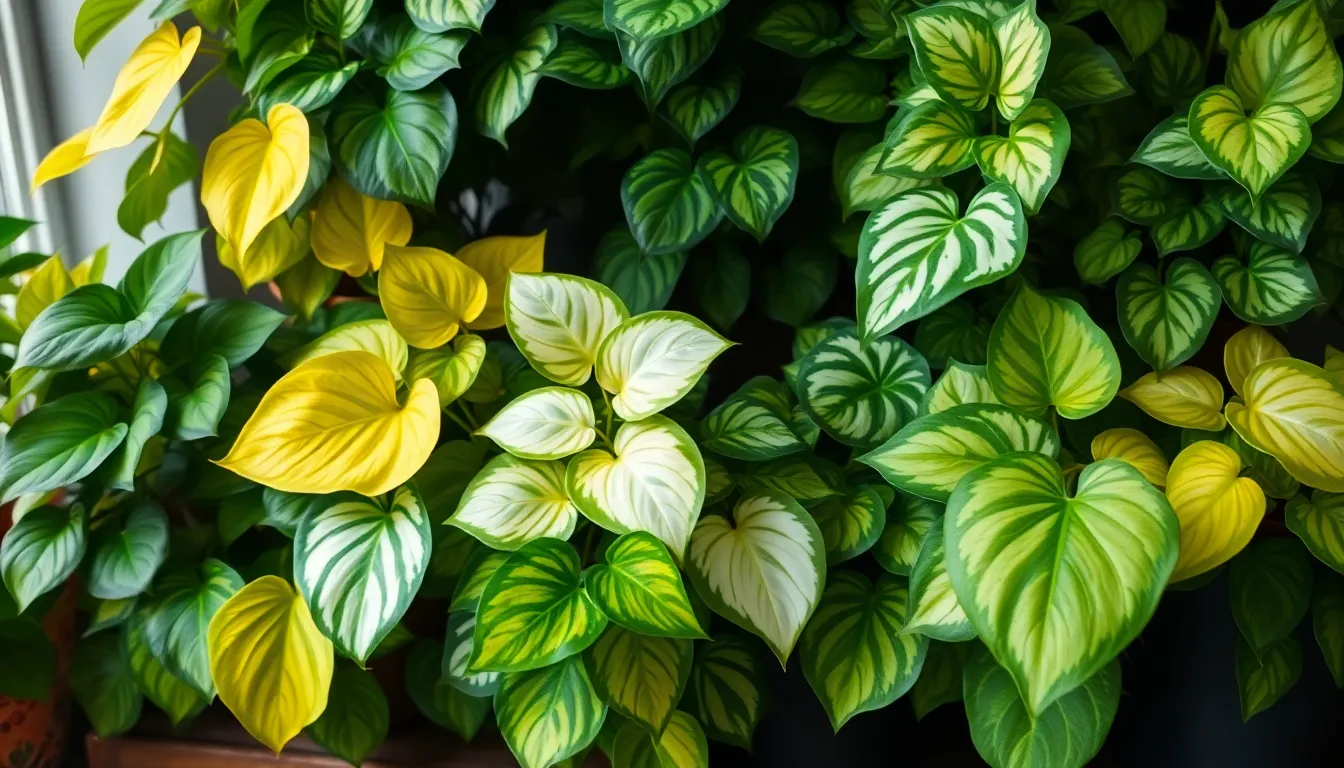
Pothos plants bring cascading elegance to our darkest indoor spaces with their heart shaped leaves and remarkable shade tolerance. These tropical vines naturally thrive in filtered light environments, making them perfect companions for our low light indoor gardens.
Best Pothos Varieties for Low-Light Areas
Golden Pothos stands out as our most reliable choice for dimly lit rooms, featuring classic green leaves beautifully splashed with yellow variegation. This variety maintains its vibrant coloring even in challenging lighting conditions.
Jade Pothos offers exceptional low light tolerance with its deep green foliage that requires minimal natural light to flourish. We recommend this variety for our darkest corners since its solid green leaves contain more chlorophyll for efficient photosynthesis in shade.
Marble Queen provides stunning white and green variegated patterns that add visual interest to shadowy spaces. Keep in mind that extreme low light conditions may cause some variegation to fade, though the plant will continue thriving.
Neon Pothos brightens our dim rooms with chartreuse colored leaves that create a natural spotlight effect. While this variety tolerates low light, it performs best with moderate indirect light to maintain its vibrant coloration.
| Variety | Light Tolerance | Variegation Retention | Best For |
|---|---|---|---|
| Golden Pothos | High | Excellent | General low light areas |
| Jade Pothos | Highest | N/A (solid green) | Darkest corners |
| Marble Queen | Good | Moderate | Decorative low light spaces |
| Neon Pothos | Moderate | Good | Brightening dim rooms |
Propagation Techniques for Indoor Pothos
Water propagation offers the simplest method for expanding our pothos collection using stem cuttings with 4 to 6 inches of vine length. Cut sections that include 3 to 4 nodes where leaves attach, then submerge these nodes in clean water.
Root development typically occurs within 1 to 2 weeks when we maintain warm conditions and change the water every few days. Once roots reach 1 to 2 inches in length, we can transplant our new plants into moist potting soil.
Direct soil propagation provides an alternative approach by planting cuttings straight into well draining potting mix. Maintain consistent moisture without waterlogging while keeping our propagation area in bright, indirect light.
Optimal conditions for successful propagation include warm temperatures around 70 to 75°F and moderate humidity levels. We can increase our success rates by covering cuttings with plastic bags to create mini greenhouse environments in low light spaces.
Cast Iron Plants: Nearly Indestructible Foliage
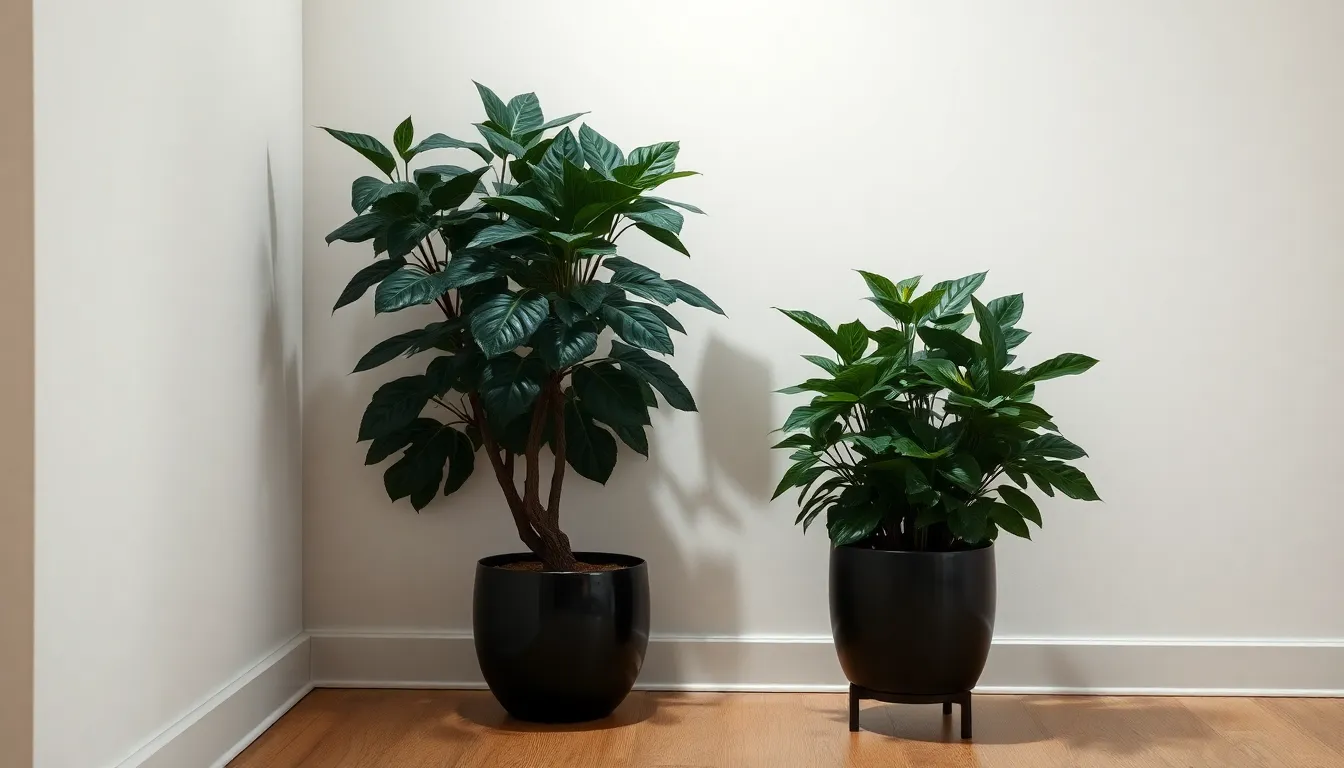
Cast iron plants (Aspidistra elatior) earn their name through legendary toughness that makes them perfect for our darkest indoor spaces. We’ve found these plants thrive where others fail, making them ideal additions to our collection of no light champions.
Understanding Cast Iron Plant Resilience
Light tolerance sets cast iron plants apart from most houseplants since they actually prefer low to moderate indirect light over bright conditions. We recommend placing them in deep shade areas where direct sunlight never reaches, as harsh rays can scorch their distinctive foliage. These remarkable plants continue growing in conditions that would kill most other species.
Watering requirements favor neglect rather than attention, making overwatering our biggest concern with cast iron plants. We allow soil to dry completely between waterings and use fast draining potting mixes with drainage holes to prevent root rot. Their drought tolerance means we can forget about them for weeks without worry.
Growth patterns remain refreshingly slow compared to other houseplants, requiring repotting only every few years during spring or summer months. We choose containers slightly larger than the root ball when transplanting, giving roots room to expand without overwhelming the plant’s natural pace.
Pest resistance proves exceptional for indoor environments, with cast iron plants rarely suffering from common houseplant problems. We occasionally encounter spider mites or scale insects that respond well to leaf rinsing or targeted insecticidal treatments when necessary.
Styling Tips for Cast Iron Plants Indoors
Placement opportunities abound in our homes’ darkest corners, hallways, and rooms lacking windows where other plants would struggle. We position them in offices, basement rooms, and interior spaces that receive minimal natural light throughout the day.
Container selection emphasizes drainage over aesthetics, though we choose pots proportionate to the plant’s size for visual balance. We ensure containers have adequate drainage holes and avoid oversized pots that retain excess moisture around the roots.
Decorative versatility complements minimalist, modern, and traditional interior design styles with their lush dark green foliage acting as natural sculptures. We use them as striking floor plants or elevate them on stands and tables where low maintenance becomes essential.
Maintenance routines require minimal effort since we avoid pruning unless removing dead or damaged leaves from the base. We wipe foliage occasionally with damp cloths to remove dust buildup and improve light absorption in already dim conditions.
Chinese Evergreens: Colorful Leaves Without Sunlight
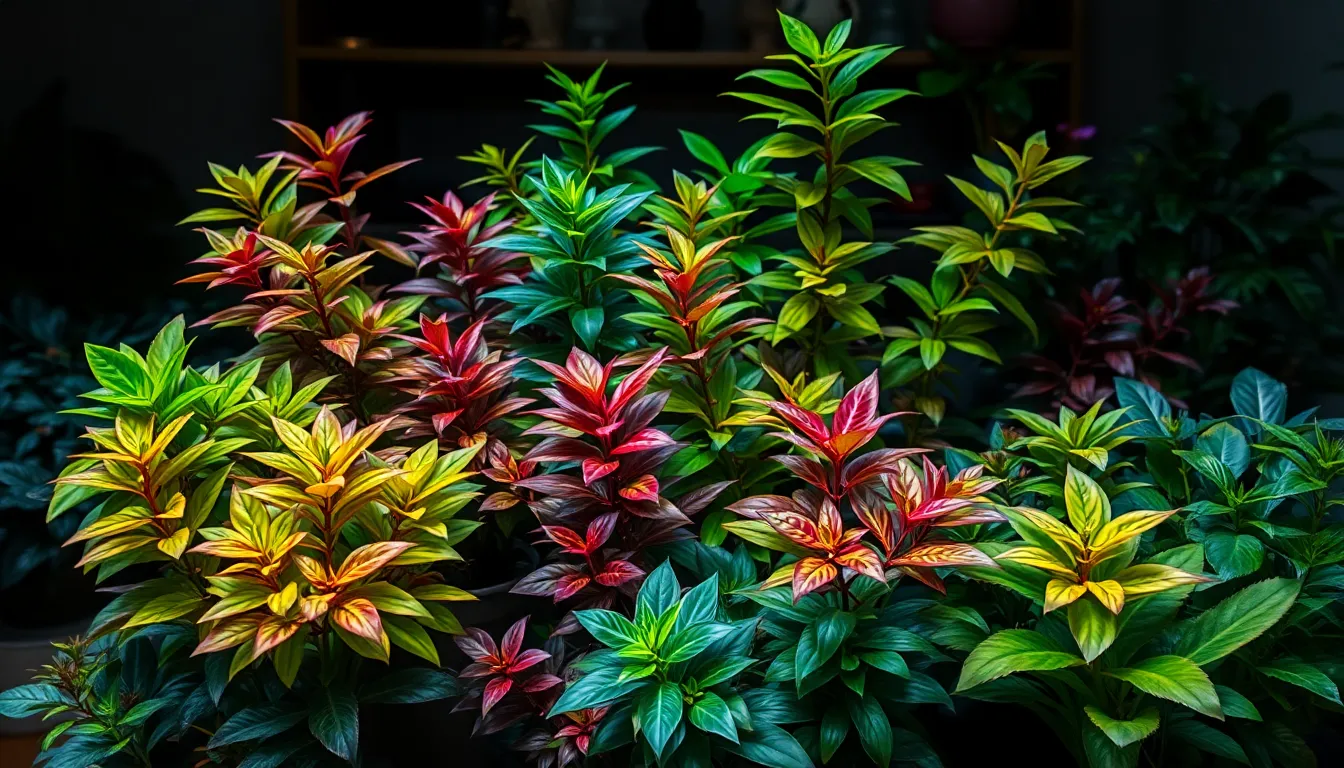
Chinese evergreens bring vibrant foliage to your darkest indoor spaces, thriving where other plants struggle to survive. These Southeast Asian natives evolved on shaded jungle floors, giving them exceptional tolerance for low light environments including artificial lighting.
Popular Chinese Evergreen Cultivars
Over 22 distinct varieties of Aglaonema offer stunning color combinations that brighten windowless rooms and dimly lit corners. ‘White Joy’ Algaonema showcases striking white and green patterns while tolerating moderate indirect light better than most colorful cultivars.
Darker green leaf varieties excel in the dimmest conditions, making them perfect for basement offices or interior bathrooms without natural light. Colorful cultivars maintain their vivid patterns in brighter indirect light but can survive in lower light conditions with some color fading.
Most Chinese evergreen cultivars reach 1 to 1.5 feet in both height and width, fitting perfectly on tabletops, bookshelves, or as elegant floor plants. Their compact size makes them ideal for smaller spaces while still providing important visual impact through their decorative foliage.
Creating Humid Conditions for Optimal Growth
Temperature control plays a crucial role in Chinese evergreen success, with optimal growth occurring between 65°F to 80°F in your indoor environment. Cold drafts and heater vents can damage these tropical plants, especially when temperatures drop below 60°F.
Humidity levels between 60% and 70% help maintain leaf vibrancy and promote vigorous growth in dry indoor climates. Room humidifiers provide the most consistent moisture control, while frequent misting offers a more hands on approach to humidity management.
Pebble trays filled with water create localized humidity zones around your plants without waterlogging the root system. Position pots above the water line on the pebbles to prevent root rot while benefiting from increased moisture in the surrounding air.
Well draining peat based soil with acidic pH levels around 5.5 to 6.5 supports healthy root development and nutrient absorption. These forgiving plants handle occasional drought and dry air conditions, though consistent moisture levels produce the best foliage displays.
Peace Lilies: Elegant Blooms in Shadowy Spaces
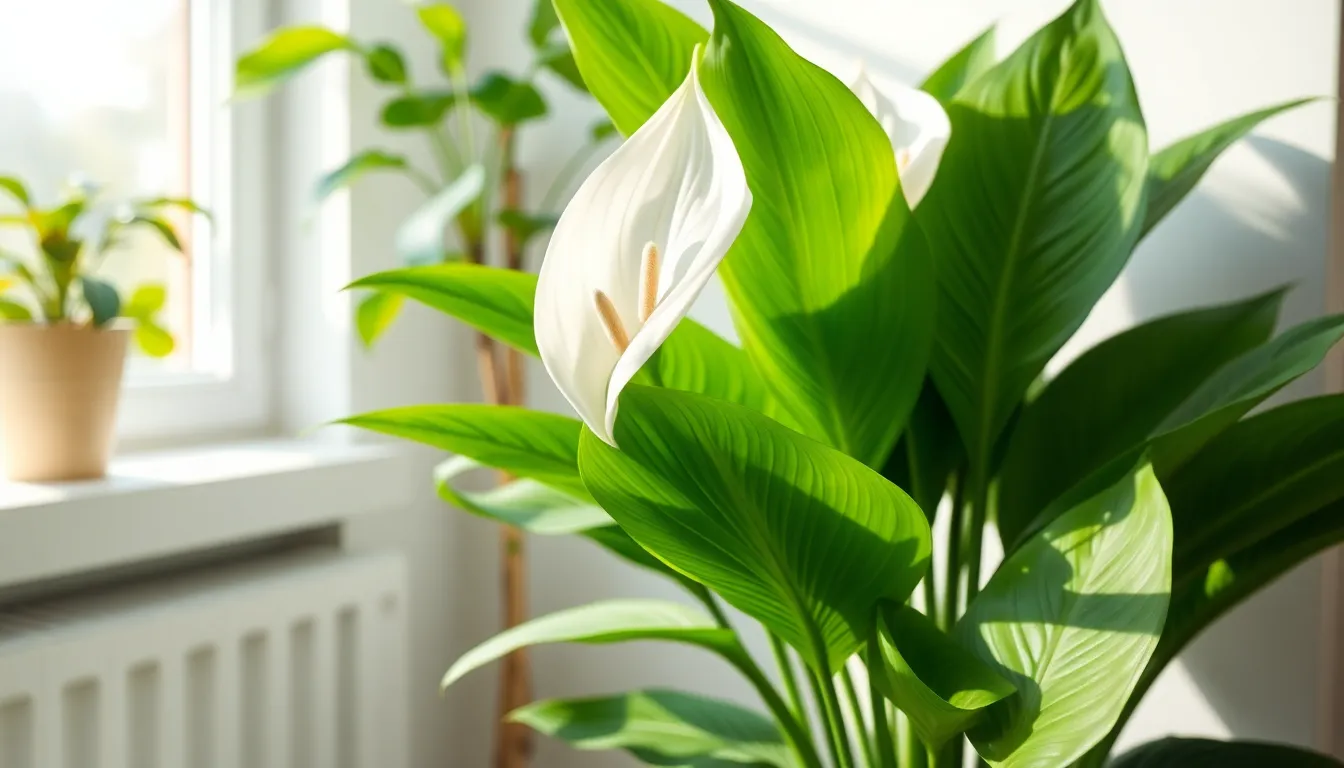
Peace lilies stand out among no light plants indoor with their stunning white spathes and glossy green foliage that thrives in dim conditions. These tropical beauties naturally grow on forest floors under dense canopy shade, making them perfectly adapted for our darker indoor spaces.
Encouraging Peace Lily Flowers Indoors
Bright indirect light near north-facing windows creates the ideal environment for peace lily blooms to develop consistently. Moving your plant gradually from darker locations to brighter spots stimulates the flowering process naturally. Temporarily placing the plant in complete darkness for a few days can mimic dormant periods and trigger blooming cycles.
Consistent moisture levels support healthy flower development when we keep soil damp but never waterlogged. Watering becomes necessary when the top inch of soil feels dry to the touch. Temperature control between 68°F and 85°F maintains optimal growing conditions while protecting plants from cold drafts.
Light fertilization every 2 to 3 months provides adequate nutrition since peace lilies aren’t heavy feeders. Occasional misting or bathroom placement increases humidity levels that these tropical plants prefer. Their white spathes can last over a month when proper care conditions are maintained.
Common Problems and Answers for Peace Lilies
| Problem | Cause | Solution |
|---|---|---|
| Not Blooming | Insufficient light | Move to brighter indirect light or try dark period treatment |
| Root Rot | Overwatering | Water only when top inch of soil dries |
| Yellow/Brown Leaves | Poor watering, low humidity, drafts | Adjust watering schedule and increase humidity |
| Pest Issues | Low humidity, poor air circulation | Regular misting and proper ventilation |
Blooming problems typically occur when peace lilies receive insufficient light for extended periods. Relocating plants to areas with better indirect lighting resolves most flowering issues within several weeks. Short dark treatments of 3 to 5 days can reset the plant’s blooming cycle effectively.
Overwatering symptoms include yellowing leaves and musty soil odors that indicate root rot development. Drainage improvement and reduced watering frequency prevent saturated soil conditions. Well-draining potting mix allows roots to breathe while maintaining necessary moisture levels.
Leaf discoloration signals environmental stress from improper watering practices or inadequate humidity. Brown leaf tips often result from low humidity levels that we can address through regular misting. Drafty locations cause temperature fluctuations that stress plants and affect leaf health.
Toxicity concerns require keeping peace lilies away from children and pets since calcium oxalate causes irritation if ingested. Strategic placement in elevated locations or rooms with restricted access ensures safety while maintaining plant health. Their elegant appearance makes them excellent choices for adult living spaces and offices.
Philodendrons: Heart-Shaped Leaves for Dark Rooms

Philodendrons bring lush greenery to spaces where other plants struggle, thriving in environments with as little as 50 foot-candles of light. Their signature heart-shaped leaves create an instant tropical atmosphere in windowless rooms and shadowy corners.
Climbing vs. Non-Climbing Philodendron Types
Climbing varieties like Philodendron hederaceum naturally grow as vines and excel in low-light conditions. These heartleaf philodendrons trail gracefully from hanging baskets or climb support structures indoors. We recommend training them onto moss poles or trellises to showcase their natural climbing behavior while maximizing vertical space.
Non-climbing philodendrons maintain a compact, bushy growth pattern that works perfectly in areas without climbing structures. Their upright habit requires less vertical space while still delivering the same low-light tolerance. Both types handle indirect light beautifully and can survive in environments where traditional houseplants fail.
Variegated options like Philodendron ‘Brasil’ need slightly more illumination than solid green varieties but still tolerate moderate low-light conditions. Direct sunlight burns their leaves and reduces the vibrant coloration we love about these plants.
Supporting and Training Indoor Philodendrons
Vertical supports encourage natural growth habits in climbing philodendrons and prevent them from becoming leggy in dim conditions. Moss poles, bamboo stakes, and wooden trellises all work effectively as climbing structures. We suggest installing supports when plants reach 12 inches in height for best results.
Regular rotation ensures even light distribution and prevents uneven growth patterns common in shaded areas. Turn your philodendrons quarter turns weekly to maintain balanced foliage development. This practice prevents leaf loss on the shadier sides of the plant.
Artificial lighting supplements natural light in extremely dark rooms using LED or fluorescent grow lights. Position lights 12 to 18 inches above the foliage for optimal results. We recommend providing 100 foot-candles of light for healthier growth in completely dark spaces.
Watering schedules require careful attention in low-humidity dark rooms where soil dries slowly. Allow soil to dry almost completely between waterings to prevent root rot. Check moisture levels by inserting your finger two inches into the soil before watering again.
Dracaenas: Architectural Plants for Minimal Light
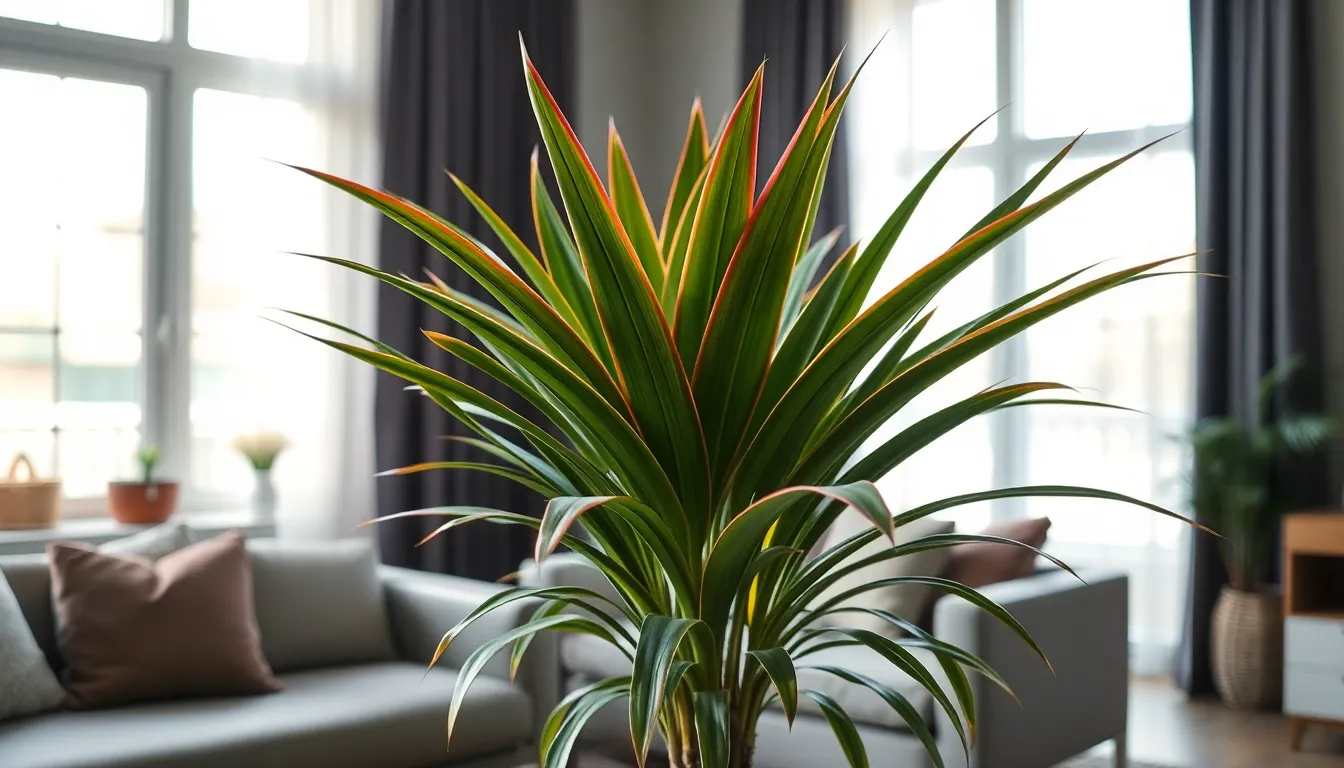
Dracaenas stand out as premier architectural houseplants that adapt remarkably well to low light conditions. These striking plants bring tropical elegance to indoor spaces while tolerating the dim environments where many other plants struggle to survive.
Dragon Tree Varieties for Indoor Spaces
Dragon Trees, primarily referring to Dracaena marginata, feature slender pointed leaves with distinctive red edges growing on tall woody stems. These plants create stunning focal points in offices, living rooms, and any space receiving filtered sunlight rather than direct sun exposure.
Multiple dracaena species offer unique characteristics for different interior design needs. Dracaena fragrans, commonly known as the Corn Plant, displays wider leaves with yellow striping that adds brightness to darker corners. Dracaena reflexa varieties provide different leaf shapes and growth patterns while maintaining the same excellent low light adaptability.
Each variety thrives in medium to low indirect light but cannot survive in complete darkness or full shade conditions. We recommend placing these plants near windows with filtered light or in rooms with consistent ambient lighting. Their upright growth habit makes them perfect for filling vertical space in modern and traditional interior designs alike.
Pruning and Shaping Dracaena Plants
Pruning dracaenas involves cutting back leggy stems just above leaf nodes to encourage bushier growth patterns. This technique helps maintain the plant’s architectural appeal while controlling its overall size in indoor environments.
Regular removal of yellow or damaged leaves keeps these plants looking their best while promoting overall health. We suggest using clean, sharp pruning shears to make clean cuts that heal quickly without inviting disease or pest problems.
Shaping through strategic pruning stimulates new shoot development, creating fuller and more attractive plant forms. Most dracaenas respond well to pruning during their active growing season, typically spring through early fall when they can recover quickly from cuts.
Occasional repotting combined with pruning maintains these plants as manageable and attractive indoor specimens. We find that pruning every few months helps prevent the stretching and legginess that can occur in low light conditions, keeping your dracaenas looking professionally maintained and architecturally striking.
Monstera Deliciosa: Statement Plants for Shaded Areas
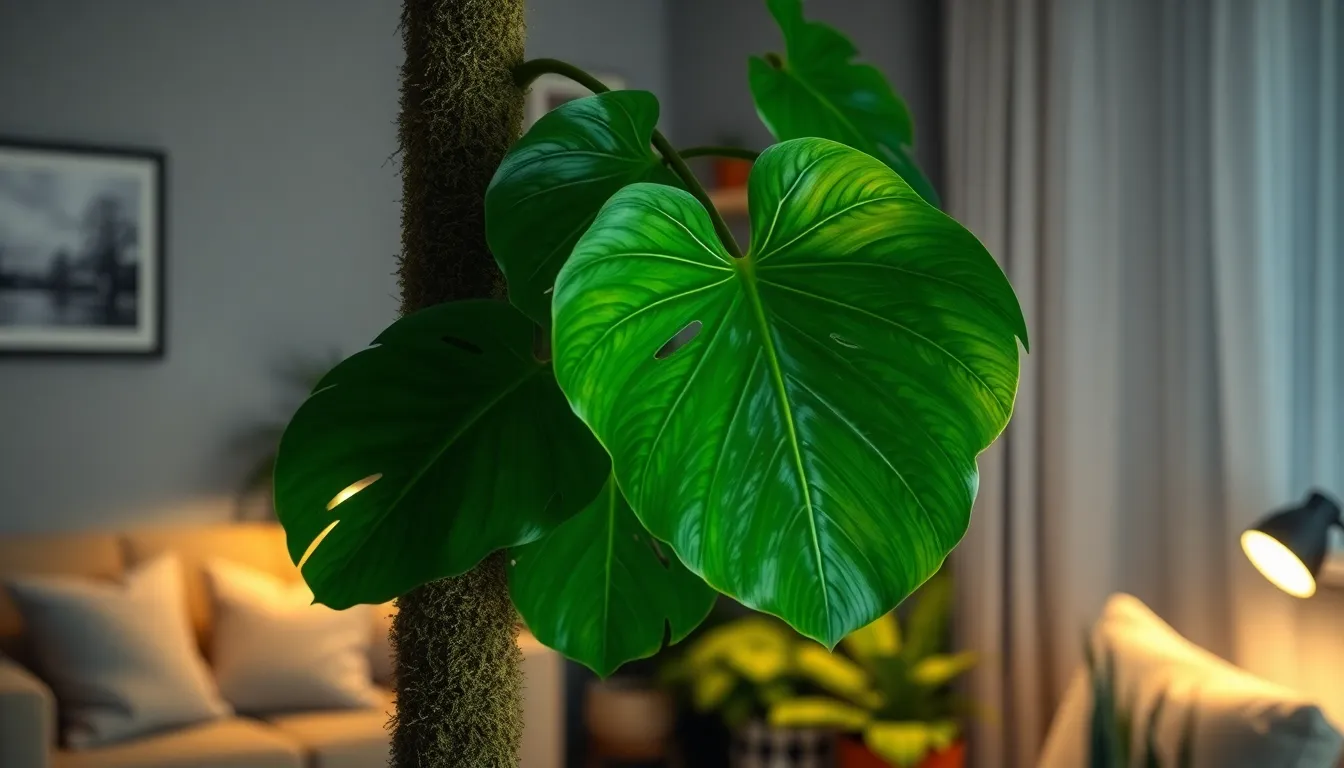
Monstera deliciosa stands out as one of the most impressive statement plants for shaded indoor areas. These tropical beauties naturally grow in the dappled light of rainforests, which makes them surprisingly well-suited for low-light environments where other plants might struggle.
Managing Monstera Size in Low-Light Conditions
Low-light conditions naturally slow down Monstera growth and create more manageable plants for indoor spaces. We’ve found that reduced light intensity limits photosynthesis, which results in slower development and smaller leaves that often lack the characteristic fenestrations (leaf holes). Growth patterns become more compact when light is limited, making these plants easier to accommodate in smaller rooms.
Pruning becomes essential for maintaining an attractive shape in shaded areas. We recommend regularly trimming leggy stems that develop when the plant stretches toward available light sources. Cut back overgrown vines to encourage bushier growth and prevent the plant from becoming too sprawling.
Water management requires extra attention in low-light settings since slower growth reduces the plant’s water uptake. Allow soil to dry more thoroughly between waterings compared to specimens in brighter locations. This approach prevents root rot, which becomes more likely when plants can’t process moisture efficiently.
Supplemental grow lights can help maintain healthier growth patterns when natural light is extremely limited. Position LED or fluorescent grow lights 12 to 18 inches above the plant for 6 to 8 hours daily to encourage better leaf development and occasional fenestration formation.
Creating Support Systems for Indoor Monsteras
Support systems become crucial for Monsteras in low-light conditions since these plants naturally climb trees in their native habitat. Vertical supports help prevent the leggy growth that commonly occurs in shaded areas while encouraging the plant to grow upward rather than sprawling outward.
Moss poles work exceptionally well for indoor Monsteras because they mimic the natural bark surfaces these plants climb in the wild. Install a moss pole when your plant reaches 2 to 3 feet in height, and secure the main stem using soft plant ties at multiple points. Keep the moss pole consistently moist to encourage aerial root attachment.
Stakes and trellises offer alternative support options that work well in darker rooms. We prefer using bamboo stakes or wooden trellises that blend naturally with the plant’s tropical appearance. Position supports behind the main growing stem and tie branches gently to encourage upward growth patterns.
Training techniques help maximize your Monstera’s exposure to available light sources. Guide growing vines toward windows or light sources using adjustable plant ties, and rotate the entire plant weekly to ensure even light distribution. This approach improves leaf development and helps maintain the plant’s natural climbing structure even in challenging lighting conditions.
Spider Plants: Easy-Care Classics for Beginners

Spider plants (Chlorophytum comosum) excel as the perfect introduction to indoor gardening for beginners seeking low-maintenance greenery. Their remarkable adaptability to various lighting conditions makes them an excellent choice for anyone wanting to expand their plant collection beyond the previously discussed varieties.
Propagating Spider Plant Babies
Propagating spider plants offers one of gardening’s most rewarding experiences through their natural production of baby plantlets. These tiny offshoots, commonly called “pups,” develop along long arching stems and create perfect opportunities for expanding your plant collection. We recommend waiting until these babies develop small white roots before separating them from the mother plant.
Cutting the baby plants requires only clean scissors and a gentle touch to avoid damaging the delicate stems. Water propagation works exceptionally well by placing the separated plantlets in a glass of clean water until roots develop further. Alternatively, we can plant the babies directly into moist potting soil for immediate establishment.
Root development typically occurs within 2-3 weeks in water, while soil propagation may take slightly longer but creates stronger initial growth. Multiple babies often grow from a single mother plant, providing endless opportunities to share with friends or create additional displays throughout your home.
Hanging vs. Tabletop Display Options
Hanging baskets showcase spider plants’ natural cascading growth pattern while maximizing their dramatic arching leaves and trailing babies. These elevated displays work particularly well in rooms with limited floor space, allowing the long stems to drape gracefully without obstruction. We find that hanging installations also protect the delicate baby plantlets from curious pets or accidental damage.
Tabletop arrangements offer equally attractive presentation options for spider plants, especially when positioned on shelves or plant stands where their foliage can spread naturally. Surface displays provide easier access for regular watering and maintenance while creating stunning focal points on desks, counters, or decorative tables.
Both display methods work effectively in low light conditions, though we recommend positioning plants near sources of indirect light for optimal growth. Rotation becomes easier with tabletop displays, allowing us to ensure even light exposure on all sides of the plant for balanced development.
Conclusion
We’ve shown you that dark corners don’t have to remain lifeless spaces in your home. With the right plant selection and proper care techniques these shadowy areas can become thriving green sanctuaries that enhance your living environment.
From the architectural beauty of snake plants to the cascading elegance of pothos each species we’ve covered offers unique benefits for low-light conditions. The key lies in understanding each plant’s exact needs and creating optimal growing conditions even without abundant natural light.
Your journey to creating an indoor jungle doesn’t require perfect lighting conditions. These resilient plants prove that with minimal effort and the right knowledge you can transform any dim space into a vibrant living area that brings nature indoors year-round.
Frequently Asked Questions
What plants thrive in dark corners with no direct sunlight?
Snake plants, ZZ plants, Pothos, cast iron plants, Chinese evergreens, peace lilies, philodendrons, dracaenas, Monstera deliciosa, and spider plants all excel in low-light conditions. These plants have adapted to survive and flourish in environments lacking direct sunlight, making them perfect for windowless bathrooms, basement offices, and other shadowy areas of your home.
How often should I water low-light plants?
Most low-light plants require less frequent watering than their sun-loving counterparts. Allow soil to dry completely between waterings for snake plants and ZZ plants. Peace lilies prefer consistent moisture, while cast iron plants favor minimal watering. Generally, water every 2-3 weeks, but always check soil moisture first to prevent root rot.
Can I grow plants in completely dark rooms?
While these plants tolerate low light exceptionally well, they still need some light to survive. For extremely dark conditions, consider supplementing with LED or fluorescent grow lights. Position lights 12-24 inches above plants and provide 12-16 hours of artificial light daily to maintain healthy growth and vibrant foliage.
Which low-light plant is best for beginners?
Spider plants and snake plants are ideal for beginners due to their forgiving nature and minimal care requirements. Both tolerate neglect well, require infrequent watering, and adapt to various lighting conditions. Snake plants are particularly resilient, while spider plants offer easy propagation opportunities through their natural “pups” or plantlets.
Do low-light plants grow slower than plants in bright light?
Yes, most low-light plants grow more slowly in dim conditions compared to brighter environments. However, they maintain their structural integrity and rich coloration. This slower growth can actually be beneficial for indoor spaces, as it means less frequent repotting and pruning, making them perfect for low-maintenance indoor gardening.
How can I prevent root rot in low-light plants?
Ensure proper drainage by using well-draining soil and pots with drainage holes. Water less frequently in low-light conditions since plants use less water. Allow soil to dry completely between waterings for drought-tolerant varieties like snake plants and ZZ plants. Good air circulation and avoiding overwatering are key to preventing root rot.
What humidity levels do low-light plants need?
Most low-light plants prefer moderate humidity levels between 40-60%. Chinese evergreens thrive in higher humidity (60-70%), while snake plants and ZZ plants tolerate lower humidity well. Create localized humidity by grouping plants together, using pebble trays filled with water, or placing a humidifier nearby, especially during dry winter months.
Can I propagate low-light plants easily?
Many low-light plants are excellent for propagation. Pothos and philodendrons root easily in water or soil. Spider plants produce natural “pups” that can be propagated while still attached to the mother plant. Snake plants can be propagated through leaf cuttings, while ZZ plants can be divided at the root level for new plants.
How do I know if my low-light plant needs more light?
Signs include leggy growth, smaller leaves, loss of variegation, yellowing leaves, or extremely slow growth. While these plants tolerate low light, they may benefit from brighter indirect light or supplemental grow lights. Move plants closer to windows or add artificial lighting if you notice these symptoms affecting plant health.
Are low-light plants safe for pets?
Some low-light plants are toxic to pets. Peace lilies, ZZ plants, and philodendrons contain compounds that can be harmful if ingested by cats or dogs. Snake plants and Monstera deliciosa are also mildly toxic. Spider plants and cast iron plants are generally considered pet-safe. Always research plant toxicity before bringing new plants into homes with pets.

